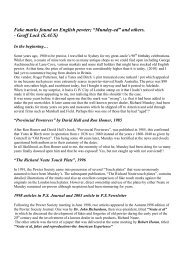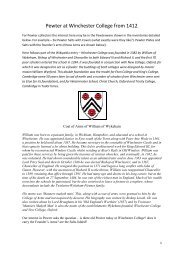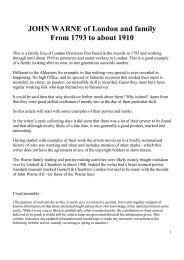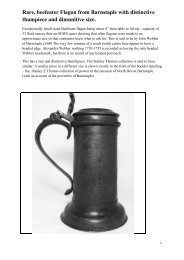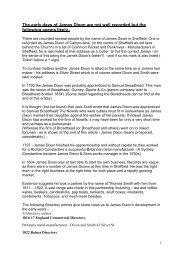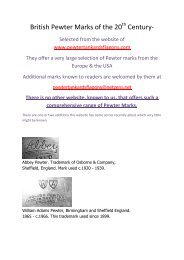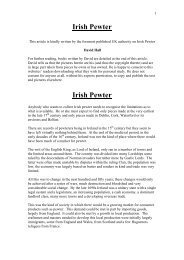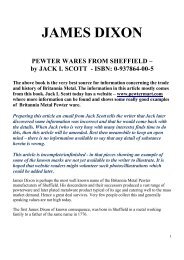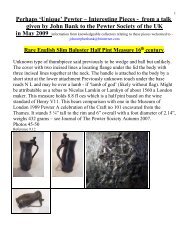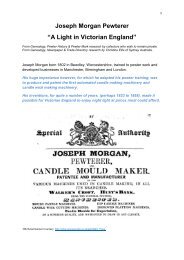Scottish Communion Pewter 1600 – 1850 - PewterBank
Scottish Communion Pewter 1600 – 1850 - PewterBank
Scottish Communion Pewter 1600 – 1850 - PewterBank
Create successful ePaper yourself
Turn your PDF publications into a flip-book with our unique Google optimized e-Paper software.
<strong>Scottish</strong> <strong>Communion</strong> <strong>Pewter</strong> <strong>1600</strong> <strong>–</strong> <strong>1850</strong>By Peter Spencer DaviesMost silver and pewter communion plate dates back to the Act passed by the <strong>Scottish</strong>Parliament in 1617 at the behest of James VI, that every Kirk should provide cups forcommunion and a laver and basin for baptism. Very little seventeenth century pewter hassurvived. Although not required under the Act, flagons were used in some churches for thecommunion wine, but no <strong>Scottish</strong>-made example is known. No lavers of this period seem tohave survived.Late seventeenth century communion cup and a basin with a central boss and maker’s mark on the rimThe early communion cups that we know of are all from the North East and are of the simplebeaker type, with a maker’s mark inside or beneath the base.Deep dishes were universally known as ‘basins’ and may have been used for the bread atcommunion and for baptism. They usually had a central boss, and the edge often had 3incised lines or reeds. There would be a maker’s mark, usually on the upper rim, or beneaththe base.Eighteenth Century 1700 <strong>–</strong> 1750 <strong>Communion</strong> flagons appeared from about 1702 onwards.They are typically straight-sided about 10½” in height, with a flat lid which has a triangular‘beak’ at the front. The maker’s mark is often beneath the lid, but may be in the base <strong>–</strong> andtherefore more difficult to see. Flagons of this period are scarce, and may haveundocumented marks. Very small flagons, of about 6” in height, are even more scarce andwere probably used as lavers.<strong>Communion</strong> cups are of interest. They typically have large bowls with a stem and foot. In theNorth East, the beaker style continued in use.Dishes of this period typically have no reeding around the edge, and as in earlier forms, havea rather straight angular ‘ booge’. The maker’s mark is now usually beneath the base.1
Early 18C flagon with ‘beak’ to front of lid, and 1704 communion dish with straight ‘booge’ (the bit between the rimand base that is normally curved in later dishes) and a plain edge. It has the earlier seventeenth century feature of a‘gutter’ around the edge of the baseEighteenth Century 1750 <strong>–</strong> 1800 A relatively large amount of communion pewter of thisperiod has survived. It is likely that all of the styles in use are now known.Flagons were as before, but without the beak on the lid.Some were very large 13 <strong>–</strong> 14” in height (left), the majority were about 10” (centre) whilst theone on the left is one of only two known that are about 6”, and are probably lavers. Aroundthe end of the century some were made with spouts and/or acorn-shaped knops to the lids.Some Glasgow makers also produced some very tall more slender flagons at this time.Two late 18C tall flagons from GlasgowStemmed communion cups were abundant, with variations in both the shape of the bowl andin the detail of the stems and bases. Deep dishes with a curved booge, and also shallowerplates and chargers, were in widespread use. Basins for baptism date from this period. Theywere 9” in diameter, with a very narrow rim and were deep i.e. more ‘basin’ shaped, and themaker’s mark was inside the base.2
Selection of late 18C communion cups. There were a great variety of stylesNineteenth century <strong>Pewter</strong> making was in decline. Some of the eighteenth century stylescontinued. <strong>Pewter</strong> was gradually replaced by Britannia Metal. This is an alloy of tin and othermetals, but with antimony in the mix, it could be rolled into thin sheets, which were thenshaped and the edges soldered. It was much cheaper to produce and was mainlymanufactured in factories in Sheffield. You can tell Britannia metal from the earlier pewterbecause it is lighter in weight and, more importantly, if you look on the inside of cups orflagons, you can see a vertical seam where the sheet metal was joined.Peter Spencer Davies July 083



